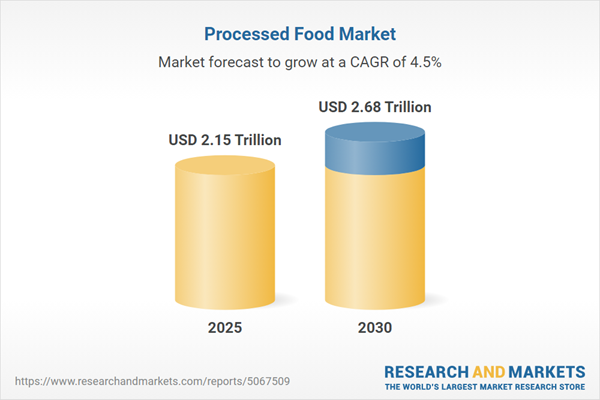Processed food refers to food that has been modified from its natural state through methods such as cooking, freezing, canning, or the addition of preservatives and other ingredients to enhance shelf life, flavor, or convenience. These foods range from minimally processed items like frozen vegetables and pre-cut fruits to heavily processed products such as canned soups, packaged snacks, and sugary beverages. Ultra-processed foods often contain numerous artificial additives and preservatives, making them so refined that whole ingredients are barely present. While convenience is a key benefit, processed foods generally provide lower nutritional value and can contribute to obesity and heart-related issues if consumed in excess.
Key Drivers of the Global Processed Food Market:
- Growing Demand for Convenience: The increasing busyness of consumers has led to a higher demand for convenient meal solutions that are quick and easy to prepare. Urbanization, advancements in food processing technology, innovations in packaging, and changing lifestyles are all contributing to the rise of processed foods that are more affordable, accessible, and long-lasting. Additionally, higher disposable incomes and a preference for ready-to-eat or on-the-go options continue to drive market growth. The variety and flavor offered by processed foods, coupled with the globalization of food brands, have further expanded their appeal worldwide.
- Rising Popularity of Canning and Freezing Methods: More individuals are becoming conscious of leading healthy lifestyles by consuming high-quality foods rich in essential vitamins and minerals that also have good shelf lives. This trend is prompting urban populations to favor easy and convenient food options. Increased spending power is also boosting the popularity of various canned foods and enhancing the demand for canning techniques in food processing.
Geographical Outlook of the Processed Food Market:
- Global Segmentation: The global processed food market is divided into five regions: North America, South America, Europe, the Middle East and Africa, and Asia Pacific.
- North America: This region is expected to hold a significant share during the forecast period due to an increasing number of companies offering advanced varieties of processed foods. Additionally, there are rising investments in research and development aimed at improving processing techniques and equipment within the established food and beverage sector.
- Asia Pacific: The Asia Pacific region is projected to experience substantial growth in market share over the forecast period as governments implement initiatives to bolster the food and beverage sector. For example, India's food processing market size is anticipated to reach US$1.27 trillion by 2027, up from US$866 billion in 2022, driven by a growing consumer base with rising disposable incomes and increasing urbanization.
Reasons for buying this report:
- Insightful Analysis: Gain detailed market insights covering major as well as emerging geographical regions, focusing on customer segments, government policies and socio-economic factors, consumer preferences, industry verticals, other sub-segments.
- Competitive Landscape: Understand the strategic maneuvers employed by key players globally to understand possible market penetration with the correct strategy.
- Market Drivers & Future Trends: Explore the dynamic factors and pivotal market trends and how they will shape up future market developments.
- Actionable Recommendations: Utilize the insights to exercise strategic decision to uncover new business streams and revenues in a dynamic environment.
- Caters to a Wide Audience: Beneficial and cost-effective for startups, research institutions, consultants, SMEs, and large enterprises.
What do businesses use our reports for?
Industry and Market Insights, Opportunity Assessment, Product Demand Forecasting, Market Entry Strategy, Geographical Expansion, Capital Investment Decisions, Regulatory Framework & Implications, New Product Development, Competitive Intelligence.Report Coverage:
- Historical data & forecasts from 2022 to 2030
- Growth Opportunities, Challenges, Supply Chain Outlook, Regulatory Framework, Customer Behaviour, and Trend Analysis
- Competitive Positioning, Strategies, and Market Share Analysis
- Revenue Growth and Forecast Assessment of segments and regions including countries
- Company Profiling (Strategies, Products, Financial Information, and Key Developments among others)
The Global Processed Food Market has been segmented as following:
- By Processing Method
- Freezing
- Drying
- Canning
- Baking
- By Product Type
- Breakfast Cereals
- Cheese and Dairy
- Canned Vegetables and Fruits
- Meat Products
- Ready Meals
- Cakes And Biscuits
- Others
- By Distribution Channel
- Online
- Offline
- By Geography
- North America
- USA
- Canada
- Mexico
- South America
- Brazil
- Argentina
- Rest of South America
- Europe
- United Kingdom
- Germany
- France
- Italy
- Spain
- Rest of Europe
- Middle East and Africa
- Saudi Arabia
- UAE
- Rest of the Middle East and Africa
- Asia Pacific
- China
- India
- Japan
- South Korea
- Taiwan
- Thailand
- Indonesia
- Rest of Asia-Pacific
- North America
Table of Contents
Companies Mentioned
- Unilever
- Nestle SA
- The Kraft Heinz Company
- The J.M. Smucker Company
- CSC BRANDS, L.P.
- ADM
- Tyson Foods, Inc.
- Kellogg NA Co.
- Conagra Brands, Inc.
- Hormel Foods Corporation
Table Information
| Report Attribute | Details |
|---|---|
| No. of Pages | 140 |
| Published | January 2025 |
| Forecast Period | 2025 - 2030 |
| Estimated Market Value ( USD | $ 2.15 Trillion |
| Forecasted Market Value ( USD | $ 2.68 Trillion |
| Compound Annual Growth Rate | 4.4% |
| Regions Covered | Global |
| No. of Companies Mentioned | 10 |









